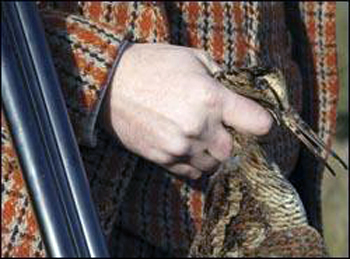Win CENS ProFlex DX5 earplugs worth £1,149 – enter here
Farmland and woodland bird populations falling in the south
While numbers of woodland birds are up by as much as 42% since 1994 in parts of the north, the story in the south is markedly different.
 Seversl woodcock were shot on the day
used 26 oct 06
Seversl woodcock were shot on the day
used 26 oct 06
The statistics are part of DEFRA?s new league table, Wild bird population indicators for the English regions: 1994-2007.
DEFRA has used figures from the Breeding Bird Survey, which is carried out by the British Trust for Ornithology and the RSPB, to plot fluctuations of bird populations in different English regions.
Of all the species, farmland birds have seen the steepest decline across England – the only two areas to see a rise are the north-east and the Yorkshire and Humber regions.
The south-east is at the bottom of the farmland bird league table with a 27% decline in population.
The Game & Wildlife Conservation Trust?s Dr Stephen Tapper said the government needs to take decisive action: ?DEFRA?s wildlife minister, Huw Irranca-Davies, is right to highlight the dwindling numbers of birds. The recent loss of set-aside will not have helped. It is important that we develop a conservation programme to replace set-aside immediately, and that it is a programme that will have the enthusiastic support of farmers.?
The RSPB?s Richard Gregory commented that the figures reflect the intensification of farming across England: ?Broadly speaking, the further north you go, the less intensive the farming. In addition, there seems to be a clear indication of the effects of climate change in these trends. On a European scale we have witnessed bird population trends correlating with climate projections, so we would expect the effects of climate change in the UK to be felt more in the south.?

The figures show that across the southern English regions, farmland bird species such as the grey partridge, the skylark and the yellowhammer fell by 13% between 1994 and 2007.
One of the most dramatic declines over a single year in the southern English regions was the 7% decrease in farmland birds between 2006 and 2007.
Though farmland birds have seen the worst declines in numbers, woodland bird numbers have also fallen, according to DEFRA.
Between 1994 and 2007 woodland bird species – which include the wood warbler, the willow tit and the lesser-spotted woodpecker – have fallen by 6% across England as a whole, which has also been attributed to intensive farming practices and climate change.
The north-west has seen the biggest increase in woodland birds at 42%, while the south-east has seen a drop of 16%.
Climate change may be implicated in the decreasing numbers of England?s birds, but other factors, including changes in woodland age, structure and management, may also partly account for these differences.
DEFRA?s report can be downloaded from www.defra.gov.uk/environment/statistics/wildlife/research/download/wdbrds200905.pdf
Let us know what you think about this!
Related Articles
Get the latest news delivered direct to your door
Subscribe to Shooting Times & Country
Discover the ultimate companion for field sports enthusiasts with Shooting Times & Country Magazine, the UK’s leading weekly publication that has been at the forefront of shooting culture since 1882. Subscribers gain access to expert tips, comprehensive gear reviews, seasonal advice and a vibrant community of like-minded shooters.
Save on shop price when you subscribe with weekly issues featuring in-depth articles on gundog training, exclusive member offers and access to the digital back issue library. A Shooting Times & Country subscription is more than a magazine, don’t just read about the countryside; immerse yourself in its most authoritative and engaging publication.







